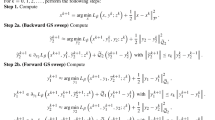Abstract
Block compressed sensing based on mixed variational inequality (BCS-MVI) is proposed to improve the performance of current reconstruction algorithms for block-based compressed sensing. In the measurement phase, an image is sampled block by block. In the recovery period, BCS-MVI takes the sparse regularization of the natural image as prior knowledge and approaches the target function within the entire image through the modified augmented Lagrange method (ALM) and alternating direction method (ADM) of multipliers. Moreover, for the reconstruction problem including two regularization terms, an adaptive weight (−AW) strategy based on the gray entropy of the initialized image is studied. BCS-MVI achieves an average PSNR gain of 0.5–2.0 dB and an SSIM gain of 0.02–0.05 over previous block-based compressed sensing methods, and the reconstructing time only slightly fluctuates with the sampling rate. The algorithm is suitable for applications in multimedia data processing with fixed transmission delays.









Similar content being viewed by others
References
Barzilai J, Borwein JM (1988) Two-point step size gradient methods. IMA J Numer Anal 3:141–148.
Becker BJ, Candes E (2009) NESTA: a fast and accurate first-order method for sparse recovery. SIAM J Imag Sci 4(1):1–39.
Blumensath T, Davies ME (2009) Iterative hard thresholding for compressed sensing. Appl Comput Harmon Anal 27(3):265–274.
Candes EJ, Romberg J, Tao T (2006) Robust uncertainty principles: exact signal reconstruction from highly incomplete frequency information. IEEE Trans Inf Theory 52(2):489–509.
Dias JB, Figueiredo M (2007) A new TwIST: two-step iterative shrinkage/thresholding algorithm for image restoration. IEEE Trans Image Process 16(12):2992–3004.
Donoho DL (2006) Compressed sensing. IEEE Trans Inf Theory 52(4):1289–1306.
Foucart S, Rauhut H (2013) A mathematical instruction to compressive sensing. Springer New York Press, USA.
Fowler JE, Mun S, Tramel EW (2011) Multiscale block compressed sensing with smoothed projected landweber reconstruction. In Proc. European Signal Processing Conference (EUSIPCO), Barcelona, Spain, 2011: 564–568
Fowler JE, Mun S, Tramel EW (2012) Block-based compressed sensing of images and video. Found Trends Signal Process (4):297–416.
Gan L (2007) Block compressed sensing of natural images. In Proc. Digital Signal Processing (DSP), Cardiff, UK, 2007:403–406
Goldfarb D, Yin W (2005) Second-order cone programming methods for total variation based image restoration. SIAM J Sci Comput 27(2):622–645.
Gu GY, He BS, Yuan XM (2014) Customized proximal point algorithms for linearly constrained convex minimization and saddle-point problems: a unified approach. Comput Optim Appl 59:135–161.
Han H, Gan L, Liu SJ, Guo YY (2015) A novel measurement matrix based on regression model for block compressed sensing. J Math Imaging Vision 51:161–170.
He BS, Yuan XM (2012) On the O(1/t) convergence rate of the douglas-rachford alternating direction method. SIAM J Numer Anal 50:700–709.
He BS, Liao LZ, Wang X (2012a) Proximal-like contraction methods for monotone variational inequalities in a unified framework I: effective quadruplet and primary methods. Comput Optim Appl 51:649–679.
He BS, Liao LZ, Wang X (2012b) Proximal-like contraction methods for monotone variational inequalities in a unified framework II: General methods and numerical experiments. Comput Optim Appl 51:681–708.
Li CB (2009) An effcient algorithm for total variation regularization with applications to the single pixel camera and compressive sensing. M.A. Rice University, USA.
Li CB (2011) Compressive sensing for 3D data processing tasks: applications, models and algorithms. USA. Ph.D. Rice University.
Mun S, Fowler JE (2009) Block compressed sensing of images using directional transforms. In Proc. Int. Conf. on Image Processing(ICIP), Cairo, Egypt, 2009
Needell D, Tropp J (2008) CoSaMP: Iterative signal recovery from incomplete and inaccurate samples. Appl Comput Harmon Anal 26(3):301–321.
Stankovic V, Stankovic L, Cheng S (2008a) Compressive sampling of binary images. In Proc. Congress on Image and Signal Processing (CISP), Sanya, Hainan, China, 2008
Stankovic V, Stankovic L, Cheng S (2008b) Compressive video sampling. In Proc. European Signal Processing Conference (EUSIPCO), Switzerland, Lausanne, 2008
Tropp J, Gilbert A (2007) Signal recovery from random measurements via orthogonal matching pursuit. IEEE Trans Inf Theory 53(12):4655–4666.
Wakin MB, Laska JN, Duarte MF, Baron D, Sarvotham S, Takhar D, Kelly KF, Baraniuk RG. (2006) Compressive imaging for video representation and coding. In Proc. Picture Coding Symposium (PCS), Beijing, China, 2006
Wang RF, Jiao LC, Liu F, Yang SY (2013) Block- based adaptive compressed sensing of image using texture information. Chin J Electron 41(8):1506–1514(in Chinese).
Xiao YH, Song HN (2012) An inexact alternation directions algorithms for constrained total variation regularized compressive sensing problems. J Math Imaging Vision 4:114–127.
Yang J, Zang Y, Yin W (2010) A fast alternating direction method for TVL1-L2 signal reconstruction from partial Fourier data. IEEE J Sel Top Signal Process 4(2):288–297.
Zhang H, Hager WW (2004) A nonmonotone line search technique and its application to unconstrained optimization. SIAM J Optim 14:1043–1056.
Zheng HB, Zhu XC (2013) Sampling adaptive block compressed sensing reconstruction algorithm for images based on edge detection. J China Univ Posts Telecommun 20(3):97–103.
Acknowledgments
The paper is supported by the National Natural Science Foundation of China (No. 61170147 and 61471124), and the Natural Science Foundation of Fujian Province (No. 2013 J01234, 2014 J01234 and 2015 J01251). The wonderful lectures and patient help of Prof. Peng Zheng in the College of Mathematics and Computer Science at Fuzhou University is greatly appreciated, as are the wonderful lectures and scholarly communications from Prof. He Bing-sheng and Mrs. Tao Ming at Nanjing University.
Author information
Authors and Affiliations
Corresponding author
Rights and permissions
About this article
Cite this article
Su, K., Chen, J., Wang, W. et al. Reconstruction algorithm for block-based compressed sensing based on mixed variational inequality. Multimed Tools Appl 75, 16417–16438 (2016). https://doi.org/10.1007/s11042-015-2975-9
Received:
Revised:
Accepted:
Published:
Issue Date:
DOI: https://doi.org/10.1007/s11042-015-2975-9




